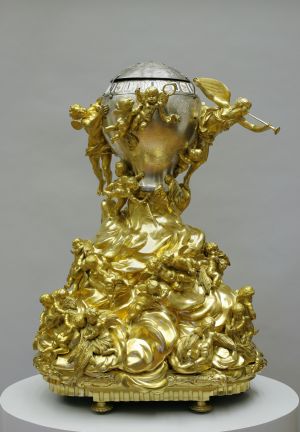MUO-015829: Balon braće Montgolfier: sat
Inventarna oznaka
MUO-015829
Naziv zbirke
Književni naziv
Naslov predmeta
Balon braće Montgolfier
Država nastanka
Godina nastanka
1784. – 1850.
Tehnika izrade
Dimenzije (v1xš1xd1)
90 × 66 × 46 cm
Opis predmeta
Sat je koncipiran kao skulptura od pozlaćene bronce, dok je mehanizam umetnut u sferično srebrno kućište. Nisko ovalno postolje stoji na šest nogu u obliku diskova. Obod mu je ukrašen nizom užljebljenja iznad kojih je vijenac sastavljen od lovorovih listova.
Donji dio sata izrazito je monumentalan, u osnovi stožast, ali razveden grudičastim nakupinama kojima su predočeni oblaci na kojima je u spiralnom nizu raspoređeno tridesetak figura putta koji nose žito, baklje i žaru s plamenom. Virtualno gibanje usmjereno je prema vrhu gdje se nalazi srebrna kugla koja simbolizira balon, a u koju je smješten mehanizam sata. U gornjoj polutki kalote 24 su otvora u obliku pravokutnika odrezanih uglova. Ispod njih je pokretni vijenac na kojem su emajlirana polja s naizmjenično crnim rimskim brojevima za označavanje sati i znakovi zodijaka. Pri hodu satnog mehanizma vijenac s oznakama se okreće, a točno se vrijeme iščitava kad se određeni broj nađe ispod kazaljke koja je fiksna.
S jedne strane uz ku
//
Sat je izveden u spomen na prvi let balona koji su 1783. konstruirala braća Montgolfier. Koncipiran je kao skulptura od pozlaćene bronce, dok je mehanizam umetnut u sferično srebrno kućište. Donji dio sata izrazito je monumentalan, u osnovi stožast, ali razveden grudičastim nakupinama na kojima je u spiralnom nizu raspoređeno tridesetak figura putta koji nose žito, baklje i žaru s plamenom. Virtualno gibanje usmjereno je prema vrhu gdje se nalazi srebrna kugla koja simbolizira balon, a u koju je smješten mehanizam. U gornjoj polutki kalote su 24 otvora ispod kojih je pokretni vijenac s emajliranim poljima na kojima se smjenjuju oznake za sate i znakovi zodijaka. Pri hodu mehanizma vijenac se okreće, a točno se vrijeme iščitava kad se određeni broj nađe ispod fiksne kazaljke. Uz kuglu je s jedne strane prislonjena figura boga vjetra Eola, a s druge strane krilata Fama.
Kućište sata oblikovno je srodno modelu za neizvedeni spomenik prvom letu balona, što ga je 1784. po narudžbi pariške Direction des Bâtiments izradio francuski kipar Clodion. Ovaj sat, rađen prema Clodionovom modelu, izuzetan je i rijedak artefakt koji nosi stilske osobine rokokoa i nadolazećeg klasicizma.
Ključne riječi
MUO baza
Autorska prava / Prava korištenja
